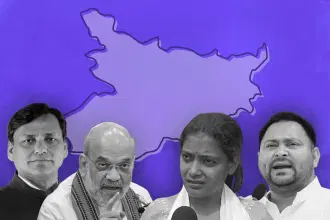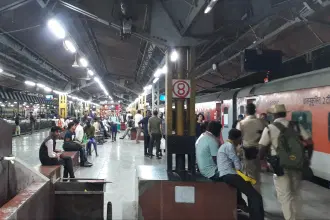Politics
Rudy Vs Balyan: How The Constitution Club Election Has Put BJP In A Fix
Abhishek Kumar
Aug 26, 2025, 01:56 PM | Updated 01:56 PM IST
Save & read from anywhere!
Bookmark stories for easy access on any device or the Swarajya app.


The Constitution Club of India (CCI) election on 13 August 2025 turned into much more than an ordinary administrative election. The high intensity and the media buzz it generated have inflamed caste tensions with far-reaching implications for India’s Hindi heartland.
Rudy-Balyan Saga
At CCI, the Lok Sabha Speaker is the ex-officio chairman, which places the responsibility for day-to-day affairs on the Secretary. Rajiv Pratap Rudy, seasoned Member of Parliament (MP) from Saran, Bihar, has held this post for more than two and a half decades. Rudy first secured the position in 1999 during the prime ministership of Atal Bihari Vajpayee.
He is considered a reformer and is widely credited with transforming dilapidated infrastructure into a thriving hub of modern facilities for legislators. Under his leadership, guest rooms, conference halls, member lounges, a gym, spa, salon, sports areas, restaurants and an outdoor café all underwent a major facelift. At CCI, Rudy has long enjoyed bipartisan support.
This year, however, he faced a challenger in Sanjiv Balyan, fellow BJP member and former MP from Muzaffarnagar. Balyan was believed to be favoured by the party, while Rudy’s fluctuating relationship with his own party continued to play out during the CCI elections. Godda MP Nishikant Dubey led Balyan’s campaign and galvanised support on his behalf.
As the contest gained momentum, it also assumed the shape of a Jat (Sanjiv Balyan) versus Rajput (Rajiv Pratap Rudy) rivalry, echoing the tensions of Western Uttar Pradesh.
Political heavyweights such as Union Home Minister Amit Shah, BJP President J. P. Nadda, Congress leader Sonia Gandhi, Congress President Mallikarjun Kharge, Piyush Goyal, Kiren Rijiju and Himachal Governor Shiv Pratap Shukla also cast their votes in this unusually high-stakes election, which saw record turnout.
The result, however, was decisive. Rudy won with 391 votes, a clear lead of 100 over Balyan’s 291. Rudy received support from multiple factions, including his party colleagues, Bihar-based leaders and members of Congress, Samajwadi Party, Trinamool Congress and Rashtriya Janata Dal. In one of his public interactions, he was also seen thanking Rahul Gandhi.
While the opposition felt emboldened by a perceived symbolic victory over Amit Shah, the timing of the election—just before the Bihar assembly polls—and the caste dynamics surrounding it may have long-term consequences for the BJP.
The aggressive campaign led by Dubey could negatively impact the Rajput-BJP-Rudy equation in Bihar and surrounding regions.
Rudy and the Rajputs of Bihar
Rudy is often regarded as one of the capable leaders sidelined by the party. His political career includes defeating Lalu Prasad Yadav, Rabri Devi, Rohini Acharya and Chandrika Roy, the father-in-law of Tej Pratap Yadav. During Atal Bihari Vajpayee’s tenure as Prime Minister, Rudy held multiple ministries.
He is also a trained pilot and an Advocate practising in the Supreme Court of India. Known for his cosmopolitan persona and fluency in English, Rudy began his political journey with grassroots campaigns, speaking in Bhojpuri. He continues to adapt to both worlds as required.
Despite his credentials, he has not been given any ministerial post in the Cabinet, surprising many observers. “One explanation is that the current BJP leadership does not favour politicians who joined the party after establishing themselves elsewhere. Another explanation is that he belongs to the era when Atal and Advani dominated, and almost all prominent leaders from that time find little favour under the new leadership,” said political consultant Suyash Jha.
Adding to his troubles was Dubey’s aggressive campaign against him, which gave the entire episode an anti-Rajput dimension. Before targeting Rudy, Dubey had publicly criticised Uttar Pradesh Chief Minister Yogi Adityanath, also a Rajput.
This internal bickering has been festering for some time, and Rudy’s sidelining is seen as part of the ongoing Mandalisation of the BJP, which many Rajputs believe has come at their expense.
According to the Bihar caste survey of 2023, Rajputs make up 3.45 per cent of the state’s population, making them the second-largest upper-caste group. Their presence in at least 140 of the 243 assembly constituencies, where their population ranges between 30,000 and 40,000, makes them a decisive factor.
This is significant in a state where more than 70 per cent of electoral victories are decided by margins of less than 10,000 votes.
Rajputs are particularly important for the BJP in the Shahabad region, comprising Bhojpur, Buxar, Rohtas and Kaimur. The NDA dominated this area until the 2010 elections, but it lost ground in 2015 when Nitish Kumar and Lalu Yadav joined forces.
In 2015, the NDA managed only six out of 22 seats in Shahabad, dropping further to two in 2020 despite contesting with Nitish Kumar as an ally. While the coalition won all four Lok Sabha seats in 2019, the victory was largely due to nationalist sentiment rather than local organisational strength.
Within BJP Bihar, both senior and younger Rajput leaders have struggled to regain influence. This was evident in the Lok Sabha elections, when former Power Minister R. K. Singh lost from Arrah. His defeat was widely attributed to internal sabotage within the state unit, which further alienated Rajput voters.
Other constituencies such as Karakat, Buxar, Sasaram, Aurangabad and even Rudy’s own Saran witnessed similar shifts in Rajput voting patterns. The NDA lost all seats in Shahabad, and a shock came in Aurangabad—often called the Chittorgarh of Bihar.
Sushil Singh, colloquially called the undeclared king of the region, lost the seat after 15 years, including 10 as a BJP MP. Between 2009 and 2014, he held it as a Janata Dal (United) member. Rudy himself won Saran by just 13,000 votes, compared to his margin of 1,40,000 in the previous election.
To counter this decline, the NDA has parachuted leaders like Narendra Modi and Amit Shah into the Shahabad region, while on the organisational front it has been prioritising backward leaders like Upendra Kushwaha. For his community, this represents a battle for self-respect.
Rajputs’ Unease with BJP
Despite some gestures of recognition, BJP has not undertaken similar outreach efforts with Rajputs. On 23 April 2025, Veer Kunwar Shaurya Diwas was organised in Patna, with Rudy playing a central role as organiser and keynote speaker.
During his address, Rudy spoke about the community’s marginalisation. “If anyone is the most persecuted in Bihar, then it is the Rajput, the Kshatriya community. If anyone is the most insulted in Bihar, it is the Rajput. If anyone is the most exploited in Bihar, it is the Rajput. If anyone is the most victimised in Bihar, it is the Rajput. So, let us resolve to free ourselves from this suffering,” he said.
“I am a soldier of my party. But my wish is that the next generation of our society should become leaders. Our daughters should become pilots, our sons officers, doctors, engineers, soldiers, businessmen—serve the nation. For this, we must educate our daughters first. Keep the agenda simple: uplift our community and move forward with everyone. We respect every caste, but if challenged, we will never remain silent. On matters of dharma, we will stand firm. On matters of self-respect, we will fight. We will never let our community’s flag fall,” he further declared.
Later, Rudy launched his Rana Sanga Yatra to invoke bravery and nationalism. The Yatra did not use BJP’s symbol, a reminder of a similar effort by him before the Lok Sabha elections. These moves have raised eyebrows within the BJP, which has not appointed any Bihari Rajput leader to the Modi 3.0 Cabinet. Even at the state level, Rajput representation remains inadequate—a ticking time bomb for the party.
Since Rudy is seen as the foremost Rajput voice in BJP Bihar, his challenges at CCI may further erode the party’s support among Rajput voters, particularly in areas bordering Uttar Pradesh.
In UP, despite Yogi Adityanath being Chief Minister, the party has struggled with Rajput voters. Even offering more than a dozen tickets to Rajput candidates did not convince them in the Lok Sabha elections. Rajput Mahapanchayats openly urged voters not to support BJP. Anupriya Patel’s remarks about Raja Bhaiya aggravated the situation.
Muzaffarnagar, represented by Sanjeev Balyan from 2014 to 2024, was one of the seats the BJP lost due to Rajput discontent. Denial of tickets to Rajput candidates in Western UP was a major source of anger. Balyan’s rivalry with Sangeet Som, former MLA from Sardhana, made matters worse.
Som’s loss in 2022 was blamed on Balyan. Reports suggest Som retaliated during the Lok Sabha elections, while the CCI contest became round two of this ongoing rivalry.
Jats and BJP’s Outreach
According to BJP insiders, it had become necessary for the party to offer Balyan a respectable platform, given the upcoming Uttar Pradesh elections.
Although the Jat community across Western UP, Rajasthan and Haryana has shown varied voting behaviour, its relationship with BJP has been volatile. In Western UP, the Muzaffarnagar riots, which pitted Jats against Muslims, were a turning point.
The BJP’s subsequent Hindutva and nationalist narrative helped it gain strong support from Jats in the 2014 general elections and the 2017 assembly polls. In later years, however, cracks appeared due to issues like farmers’ protests and regional imbalances. Despite this, the Modi-Yogi factor and careful manoeuvring kept Jat support from collapsing in 2022 and 2024.
In Haryana, BJP has largely pursued non-Jat politics, given Bhupinder Singh Hooda’s dominance over Jat voters. Here, BJP has relied mostly on nationalistic appeals, which have little impact on state politics.
Jat reservation controversies and the farmers’ protest strained ties further. Months before assembly elections, BJP removed O. P. Dhankar, a Jat, from the state unit presidency, signalling a continuation of its non-Jat strategy, which ultimately worked.
The same story played out in Rajasthan, where BJP has failed to pull Jats away from Congress.
The party’s tendency to alienate popular Jat leaders has compounded its challenges. After the controversy with former Jammu and Kashmir Governor Satyapal Malik, the resignation of farmer leader Jagdeep Dhankhad as Vice-President deepened distrust.
“Dhankad did not receive a proper exit and his abrupt resignation was seen as a sacking by the community. Within days, Malik also passed away due to health complications. He too was denied a state funeral, which Jats did not take kindly,” said Arunoday Gupta, a grassroots consultant in Haryana politics.
“Historically, Jats have been swing voters with only a few pockets of fixed loyalty. Disrespect to leaders like Malik and Dhankad could shift momentum significantly, and the BJP leadership understood this,” he added.
This made it essential for the BJP to support Balyan and counter discontent among Jats. A senior BJP functionary told Swarajya: “For BJP, it had become almost a certain necessity to field Balyan and adjust him at a respectable position to accentuate the discontent emerging from Jats. The party has long been accused of ignoring Jats’ issue.”
The party was prepared to risk temporary displeasure from Rajputs for this. However, the opposition capitalised by aligning with Rajiv Pratap Rudy. The election received more than expected coverage, and Rudy’s politically conscious voter base monitored it closely.
Still, BJP believes the fallout will be manageable. “CCI elections mainly took place in Delhi and their impact is limited on actual voting sentiments. He ultimately won and this is what matters to anyone,” said BJP spokesperson Mrityunjay Sharma.
By standing with Balyan, BJP’s top leadership believes it has successfully conveyed a message of respect to the Jats.
Abhishek is Staff Writer at Swarajya.





